Traffic lights
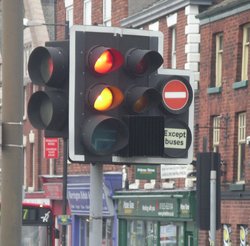
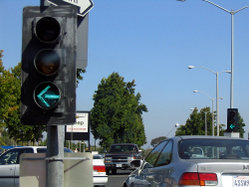
A traffic light or traffic signal is a signalling device positioned at a road intersection or pedestrian crossing to indicate when it is safe to drive, ride or walk, using a universal color code.
Introduction
Traffic lights for normal vehicles or pedestrians always have two main lights, a red one which means stop and a green one which means go. Usually, the red light contains some orange in its hue, and the green light contains some blue, to provide some support for people with red-green color blindness. In most countries there is also a yellow (or amber) light, which when on and not flashing means stop if able to do so safely. In some systems, a flashing amber means that a motorist may go ahead with care if the road is clear, giving way to pedestrians, and to other road vehicles that may have priority. A flashing red essentially means the same as a regular stop sign. There may be additional lights (usually a green arrow or "filter") to authorize turns (called a lead light in the U.S., because it is usually leading the main green light).
Traffic lights for special vehicles (such as buses or trams) might use other systems, such as vertical vs. horizontal bars of white light.


In most countries, the sequence is red (stop), green (go), amber (prepare to stop). In the UK, Hong Kong (but not mainland China), Germany and Poland among others, the sequence includes red + amber together before green, which helps draw attention to the impending change to green, to allow drivers to prepare to move off. (In many of these jurisdictions, such as the UK, it is customary for drivers to set the parking brake at red lights; the additional phase gives the driver time to release the brake before the light turns green). The single flashing amber signal is used in the UK and Australia at Pelican crossings. Some older signals in New England, U.S, mainly near Boston, use the red + amber phase to signify an all-pedestrian phase ("Barnes dance"), as they were installed before pedestrian signals came to the area, and before the national standard prohibited them. See "#Pedestrian scrambles" below, or the main article.
Depending on the jurisdiction, traffic may turn after stopping on a red (right in right-driving countries; left in left-driving countries), provided they yield to pedestrians and other vehicles. In some jurisdictions which generally forbid this, a green arrow sign next to the traffic light indicates that it is allowed at a particular intersection. Conversely, jurisdictions which generally allow this might forbid it at a particular intersection with a "no turn on red" sign, or might put a green arrow to indicate specifically when a right turn is allowed without having to yield to pedestrians (this is usually when traffic from the perpendicular street is making a left turn onto one's street and thus no pedestrians are allowed in the intersection anyway). Some jurisdictions allow turning on red in the opposite direction (left in right-driving countries; right in left-driving countries) from a one-way road onto another one-way road; some of these even allow these turns from a two-way road onto a one-way road. Also differing is whether a red arrow prohibits turns; some jurisdictions require a "no turn on red" sign in these cases. A study in the State of Illinois concluded that allowing drivers to proceed straight on red after stopping, at specially posted T-intersections where the intersecting road only went left, was dangerous. Proceeding straight on red at T-intersections where the intersecting road only went left was once legal in Mainland China with right-hand traffic provided that such movement would not interfere with other traffic, but when the Road Traffic Safety Law of the People's Republic of China took effect on 1 May 2004, such movement has since been outlawed. [1]
In France and Spain permission to turn right (or more rarely to turn left or to go straight on) on a red light is indicated by a flashing amber arrow (cars do not have to stop but must yield way to other cars and pedestrians).
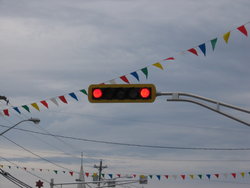
Another distinction is between intersections that have dedicated signals for turning across the flow of opposing traffic and those that do not. Such signals are called dedicated left-turn lights in the United States (since opposing traffic is on the left); it is a "protected" signal if a red arrow appears after the phase; a "permissive" signal, in a configuration known as a "doghouse", has no red left arrow, and the red ball is in the middle, above the left and straight columns. If there is such a signal, it turns green when traffic may turn left without conflict, and turns red or disappears otherwise. If there is no such signal, one must yield to opposing traffic and turn when it is safe to do so. In the U.S., many inner-city and rural areas do not have such dedicated lights, while most suburban areas have them. Such lights tend to make intersections safer and may speed up through traffic by reducing the risk of head-on collisions, but may decrease the overall efficiency of the intersection as it becomes congested, depending on what proportion of traffic is turning.
Intersections without dedicated protected signals occasionally have what is known as a "left turn trap" (in right-driving countries). This happens when traffic proceeding the other way gets a green light for a longer period of time than the direction of a turning vehicle, to allow opposing left turns to proceed (and the other direction may have a "delayed green", allowing left turns in this direction). A driver that has entered the intersection on green to turn left is trapped when the light turns red, as the other direction still has a green light, and the driver has no way of knowing when that direction will change, despite the right to proceed.
Traffic light failure in most jurisdictions must be handled by drivers as a four-way stop (or, in Europe, a priority-to-the-right intersection), pending the arrival of a police officer to direct traffic. Some jurisdictions (e.g. Switzerland, France or Austria), however, have additional right-of-way signs mounted above the traffic lights; these kick into effect when the lights are no longer active. In preparation for Y2K, some jurisdictions installed emergency unfoldable stop signs at intersections.
Mounting
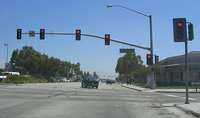
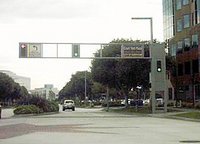
There are significant differences from place to place in how traffic lights are mounted or positioned so that they are visible to drivers. Depending upon the location, traffic lights may be mounted on poles situated on street corners, hung from wires strung over the roadway, or even hung from horizontal poles or installed within large horizontal gantries that extend out from the corner and over the right-of-way. In the last case, such poles or gantries often have a lit sign with the name of the cross-street.
Some places mount lights with their multiple faces arranged horizontally and others vertically.
California is particularly fastidious in ensuring that drivers can see the current state of a traffic light. One entrance to a typical large intersection, with three through lanes, two dedicated left-turn lanes, and a crosswalk, may have as many as three traffic lights for the left-turn lanes, three for the through lanes, and a pedestrian signal for the crosswalk. And those numbers must be multipled by four to cover all four ways to enter a typical intersection.
In addition to being positioned and mounted for desired visibility for their respective traffic, some traffic lights are also aimed, louvered, or shaded to minimize mis-interpretation from other lanes. For example, a Fresnel lens on an adjacent through-lane signal may be aimed to prevent left-turning traffic from anticipating its own green arrow.
Shades and backpanels are also useful in areas where sunlight would diminish the contrast and visibility of a signal face.
Traffic signals in Germany are located at the stop line on same side of the intersection as the approaching traffic and are often mounted overhead as well as on the right and left sides of the road. The stop line alignment is done to prevent crosswalk blocking and allow for better pedestrian traffic flow.
History
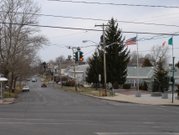
On 10 December 1868, the first traffic lights were installed outside the Houses of Parliament in London. They resembled railway signals of the time, with semaphore arms and red and green gas lamps for night use.
The modern electric traffic light is an American invention. As early as 1912, Salt Lake City policeman Lester Wire set up the first red-green electric traffic lights. On 5 August 1914, the American Traffic Signal Company installed a traffic signal system on the corner of 105th Street and Euclid Avenue in Cleveland, Ohio. Based on the design of James Hoge, it had two colors, red and green, and a buzzer to provide a warning for color changes. The first three-color traffic lights were introduced in New York and Detroit in 1920.
The first interconnected traffic signal system could be seen in Salt Lake City, Utah in 1917, with six connected intersections controlled simultaneously from a manual switch. Automatic control of interconnected traffic lights was introduced March 1922 in Houston, Texas.[2]
The
first Automatic experimental traffic
lights in England were deployed in Wolverhampton in 1927. [3]
Garrett Morgan is sometimes mistakenly credited as the inventor of the traffic light. See [4].
The traffic light is an example of a finite state machine.
Pedestrian traffic lights in East Berlin
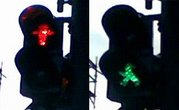
The German Democratic Republic had pedestrian traffic lights with a design quite different from the one in use in the West. East Germans strongly resisted the idea of converting to the less interesting West German stick figures during the reunification of Germany, and as a consequence, the little man (the "Ampelmännchen") of the East Berlin traffic lights has become a symbol of East Berlin. They are so popular that they are featured on lots of tourists items and souvenirs.

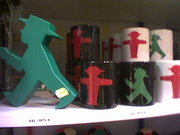
Technology
In the mid 1990s, cost-effective traffic light lamps using light emitting diodes (LEDs) were developed; prior to this date traffic lights were designed using incandescent halogen light bulbs. Unlike the incandescent-based lamps, which use a single large bulb, the LED-based lamps consist of an array of LED elements, arranged in various patterns. When viewed from a distance, the array appears as a continuous light source (unless closely examined).
LED-based lamps have numerous advantages over incandescent lamps; among them are:
- Much greater energy efficiency
- Much longer lifetime between replacement, measured in years rather than months. (Replacing traffic light bulbs is expensive)
- Brighter illumination.
- The ability to display multiple colors and patterns from the same lamp. Individual LED elements can be enabled or disabled, and different color LEDs can be mixed in the same lamp.
The operational expenses of LED-based signals are far lower than equivalent incandescent-based lights. As a result, most new traffic light deployments in the United States and elsewhere have been implemented using LED-based lamps; in addition many existing deployments of incadescent traffic lights are being replaced. (LEDs are also replacing incadescent lamps in many other applications, such as vehicle taillights). Many of the more exotic traffic signals discussed on this page would not be possible to construct without using LED technology.
Pedestrian scrambles
A pedestrian scramble, or Barnes Dance (named for Henry Barnes), is a special traffic light that stops all vehicular traffic. Pedestrians then have exclusive access to the intersection and can diagonally cross the intersection. Pedestrian scrambles are useful when there is heavy diagonal pedestrian traffic, or heavy pedestrian traffic in general. In intersections with heavy pedestrian traffic, pedestrians have the right of way, blocking drivers from turning. A pedestrian scramble gives vehicles exclusive access to the intersection for a period of time as well.
Usually these are displayed as simply a red signal in all directions with walk signals; some older intersections, at least in the Boston area, show both red and amber signals in all directions for this.
Hachiko Square, in Shibuya, Tokyo, has a famous pedestrian scramble at an intersection of seven streets (some pedestrian-only) in front of Shibuya Station.
In the United States, the city of Beverly Hills is famous for being the first California city to implement diagonal crossing (at some intersections on Rodeo Drive).
In Trondheim, Norway, nearly all the traffic lights in the centre of the city are pedestrian scrambles.
Control and synchronization
Control systems for traffic lights are based on various methods. The simplest control system uses a timer; each phase of the signal lasts for a specific duration before the next phase occurs; this pattern repeats itself regardless of traffic. Many older traffic light installations still use timers; timer-based signals are effective in one way grids where it is often possible to synchronize the traffic lights to the posted speed limit.
More sophisticated control systems use electronic sensor loops buried in the pavement to detect the presence of traffic waiting at the light, and thus can avoid giving the green light to an empty road while motorists on a different route are stopped. A timer is frequently used as a backup in case the sensors fail (they often do); an additional problem with sensor-based systems is that they may fail to detect vehicles such as motorcycles or bicycles and cause them to wait forever (or at least until a detectable vehicle also comes to wait for the light). The sensor loops typically work in the same fashion as metal detectors, small vehicles or those with low metal content may fail to be detected.
It is also commonplace to alter the control strategy of a traffic light based on the time of day and day of the week, or on other special circumstances (such as a major event causing extra traffic through an intersection).
Attempts are often made to synchronize traffic lights so that drivers encounter long strings of green lights. This is done easily only on one-way streets with fairly constant levels of traffic. Two-way streets are often arranged to correspond with rush hours to speed the heavier volume direction. Congestion can often throw off any synchronization, however. In other cases, traffic lights are synchronized to prevent drivers from encountering a long string of green lights, in order to discourage speeding.
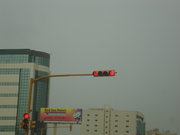
More recently even more sophisticated methods have been employed. Traffic lights are sometimes centrally controlled by monitors or by computers to allow them to be coordinated in real time to deal with changing traffic patterns. Video cameras, or sensors buried in the pavement can be used to monitor traffic patterns across a city. Unsynchronized sensors occasionally impede traffic by detecting a lull and turning red just as cars arrive from the previous light. To prevent this, the most high-end systems use dozens of sensors and cost millions of dollars per intersection, but can very finely control traffic levels. This relieves the need for other measures (like new roads) which are even more expensive.
In some areas traffic lights may also be turned off late at night when traffic is very light. Under these circumstances, traffic in the main street may get a flashing amber to warn of an intersection. Traffic in the secondary street gets a flashing red (see above), or sometimes the lights are marked as operating at set times only. In many parts of Europe, traffic light-controlled intersections also have yield and right-of way signs in case the signals fail or are turned off. Some lights outside of fire stations have no green, as they may only turn amber and then red while fire trucks are exiting the station en route to an emergency. See also the "Unusual traffic-light usages" described below.
Preemption
Some regions have signals that are interruptible, giving priority to special traffic. This is usually reserved for emergency vehicles such as ambulances and police squad cars, though sometimes mass transit vehicles including buses and light rail trains can interrupt lights. There have been some concerns that unauthorized people may have obtained devices that can trigger light preemption. Most of the systems operate with small transmitters that send radio waves or infrared signals that are received by other devices on or near the traffic lights. Sometimes, an additional signal light is placed nearby to warn motorists that an oncoming vehicle is preempting the signals. In one recent Oregon incident (2005) a fire engine pre-empted a signal at a light rail crossing, and proceeded to collide with a light-rail train. A subsequent inquiry determined that the light-rail driver was at fault; falsely believing that once the LRT had obtained the right-of-way across an intersection, it could not be lost until the train had cleared the intersection. Normally, this was the case, but pre-emption by an emergency vehicle was an exception to the rule.
Another type of preemption is railroad preemption. Traffic-signal-controlled intersections next to railroad crossings on one of the roads usually have this feature. Approaching trains activate a routine where, before the train signals and gates are activated, all traffic signal phases go to red, except for the signal immediately after the train crossing, which turns green (or flashing yellow) to allow traffic on the tracks to clear (in some cases, there are auxillary traffic signals prior to the railroad crossing which will turn red, keeping new traffic from crossing the tracks. This is in addition to the flashing lights on the crossing gates themselves). After enough time to clear the crossing, the signal will turn. The crossing lights may begin flashing and the gates lower immediately, or this might be delayed until after the traffic light turns red. The operation of a traffic signal while a train is present may differ from municipality to municipality. In some areas, all directions will flash red, turning the intersection into an all-way stop. In other areas, the traffic parallel to the railroad track will have a green light for the duration of the train while the other directions face a red light for the duration of the train. The Chicago Drive/Ivanrest Avenue intersection in Grandville, Michigan, gives Chicago Drive traffic (parallel to the tracks) a flashing yellow with fiber-optic lit signs indicating "no right turn" or "no left turn" over the tracks, and Ivanrest traffic faces a solid red light. In Goshen, Indiana, the signals at the intersections on Linconlway will run normally, with the exception that oncoming traffic (across from the railroad crossing) will face "doghouse" signals with left and right arrows lit: all traffic is required to turn left or right if a train is present, to keep traffic moving.
There has been recent concerns about the security of traffic light preemptive systems and the actual underlying network controlling them and traffic lights in general. An article in the hacker E-zine Phrack has outlined flaws in the traffic controlling system that could allow an unauthorized malicious person to abuse it as he sees fit. By issuing valid signal controlling messages from the area traffic control center if gained access to, an attacker could essentially control any phase, test phase, preemptive signals, or any function of the traffic system that is controllable remotely. The article also sparked a response by Transport for London where it is reported that a skilled attacker armed with this “step-by-step” guide could in fact cause malicious damage, as reported by a Transport for London spokesman.
In lieu of preemptive mechanisms, in most jurisdictions, emergency vehicles are not required to respect traffic lights, but must activate their own emergency lights when crossing an intersection against the light, in order to alert oncoming drivers to the preemption.
Unusual traffic-light usages
In parts of Canada (the Maritime Provinces, Quebec, Ontario and Alberta), a flashing green light has a special meaning. It is identical in meaning to signals where one side has both green and a green left-turn arrow, and the opposite side has red (cross-traffic has red as well). The light phase is known as "advanced green", and a sign saying "Advanced green when flashing" is usually attached to the light in question. The opposite side often has a sign attached to their lights saying "Delayed Green Wait for signal." Advanced green indicates that the opposing traffic is facing a red light, and it is safe for you to turn left. In Ontario, older lights with this system are slowly being phased out in favour of more universally-understood left-turn arrow signals.
In Winnipeg, Manitoba, Canada, some of the older signals have a phase where there is a red light illuminated simultaneously with a green straight arrow. The meaning of this odd configuration is that a motorist may proceed straight, but is restricted from turning both left and right.
In British Columbia and Massachusetts and a few other states, a flashing green signal is used to warn of a crosswalk at which pedestrians have the ability to stop traffic to allow a safe crossing. They may also be used at a drawbridge. The flashing green indicates that the signal is not currently in use. It changes to solid green for a short time before entering the normal yellow/red/green sequence, then returns to flashing green until another crossing is requested.
In Oregon (and elsewhere in the United States) signals with a flashing yellow arrow are being phased in to replace the 5-lamp protected/permitted signals in widespread use. Two models of this signal have been seen in Oregon; one with 4 lamps--a (solid) red arrow, a (solid) yellow arrow, a (flashing) yellow arrow, and a (solid) green arrow; and another with 3 lamps--a solid red arrow, a solid yellow arrow, and a third lamp which can either be a solid green or a flashing yellow arrow. The solid arrows all have their usual meanings; a flashing yellow arrow indicates a "permitted" left-hand turn (drivers may turn left without stopping, but opposing traffic has the right-of-way). Unlike the five-lamp protected/permitted signals, the 3/4 lamp signal with flashing yellow arrow has one unusual configuration; if traffic in one direction has a protected left turn (green arrow) along with a green light for traffic heading straight--the signals in the opposite direction can (and do) show a red light for traffic going straight, but a flashing yellow for traffic turning left. Thus the traffic facing a green light has fully protected left turns (oncoming traffic is stopped) but straight-through traffic is not fully protected --left turns across its path from the opposite direction may be legal. However, the straight-through traffic does have the right of way.
In Austria, Estonia, Latvia, most of Israel, parts of Mexico, Turkey, and Russia, the green lights will start flashing at the end of the Go or Turn phase to indicate that the amber (Caution phase) lights are about to be engaged. This is useful in fast paced roads to allow for longer slowing down time.
In Michigan, a flashing red ball signal on a "protected" left turn traffic signal indicates that left turning traffic may, after a full stop, complete their turn if and only if there is a long enough break in oncoming traffic. The flashing red usually occurs when the oncoming traffic has a green signal. This function is not enabled at intersections where it may not be safe to do so (restricted view of oncoming traffic, heavy pedestrian crossings, or double-lane left turns are good examples). It is also worthy to note that Michigan usually indicates signals that are dedicated to turning traffic with a sign displaying "LEFT" or "RIGHT". This sign is normally illuminated at night.
In some cities (such as Kiev, Ukraine or Kraków, Poland) there are signs displaying how fast one has to drive in order to reach the next intersection at the exact time when the light turns green. It is very useful in heavy traffic, and is typically set to the speed limit (eg. 60km/h).
In some parts of the United States, traffic lights have been fitted to slowly strobe white lights superimposed on the center of the red light when the red light itself has been illuminated. These seem to be located in situations where the driver may have been travelling for a length time without seeing any traffic lights (such as a controlled-access highway), in a place where a regular traveler wouldn't expect a signal (such as a newly erected signal or one put up for contstruction) or in other situations where extra work may be needed to draw attention to the status of the light (such as in an area where many other red lights approximate the brightness, placement and color of a red traffic signal). These are also used in areas prone to fog, as the strobing white light may be visible from a distance while the standard red light is not.
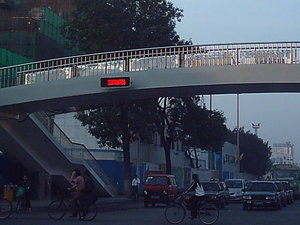
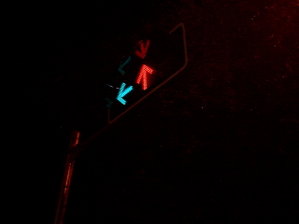
Tianjin in the People's Republic of China has two very special systems of traffic lights, in use since c. 1999/2000:
- One system is where there is a horizontal bar in a specific colour, with the colour changing and the bar shrinking. The shrinking bar indicates the time remaining in that colour. The colour itself is either red (stop), yellow or green (go). A blinking green one-third-full bar means "reduce speed now", and a blinking yellow full-bar indicates "proceed with caution".
When lights of this system turn from green to red, the diminishing green bar will flash once two-thirds (note: not the full bar) of the green bar is "eaten up", with the remaining third intact. A full, uninterrupted yellow bar will appear for a few seconds before, after a short blink, lights turn red. Immediately after the full red bar appears, a tiny (almost unnoticeable) split/division appears to signify the bit that will not be "eaten up". This corresponds to the usual position of a red light (leftmost, or rightmost if at the other end of the road and at the other side of the pavement; or the upper third). When two-thirds of the red bit is "eaten up", the red light extinguishes, only to be replaced nearly immediately with a full chunk of green (again with the minute division). The process then repeats itself.
- Another system is where there is a set of three lights as traffic lights, but every light is an arrow pointing in different directions and every arrow has a colour of its own, to show whether traffic flow is permitted or prohibited in that direction.
The major disadvantage of this system of traffic light is that it is unfamiliar to those who are used to seeing specific colours of the traffic lights at the various ends of a normal traffic light itself (e.g. green rightmost, red leftmost, etc)... It does, however, conserve space.
Elsewhere in China, a blinking green light means "reduce speed now", attempting to stop cars from passing (if that car can still safely stop in time) and is nearly universal in appearance. Some cities or parts of cities show the number of seconds remaining in a specific traffic light colour (a so-called "countdown meter").
The City of Diadema (Metropolitan Area of São Paulo, Brazil) has special traffic lights that show time remaining (in seconds) for both drivers and pedestrians. At every moment, one can tell how much time one has to pass the crossroads.
Other places where there may be traffic lights (normal or special ones):
- at the landing-stage of a ferry and aboard the ferry
- at the entrance and exit of a parking place or garage
- at the entrance and exit of some car washes
- at a ramp meter
- before a drawbridge
- before a narrowing of the road
- at a fire station
- at a tunnel entrance
- HOV Lanes
- to allow cattle to cross - as on the A470 in Wales.
Traffic lights for pedestrians are usually different, see pedestrian crossing. Traffic lights at level railroad crossings are again different. Both of these are to avoid confusion as to whom the signal applies.
On some large toll bridges, such as the San Francisco-Oakland Bay Bridge, red/green traffic lights are used to stagger traffic leading into the bridge. In the Bay Bridge's case, approximately 25 lanes of toll booth traffic are reduced to five lanes of bridge traffic in about 1/2 mile. To accomplish this, an overhead red/green traffic light is visible above each lane, several hundred feet beyond the toll plaza. Green is illuminated for 2 seconds, signalling the first driver in that lane to begin acceleration. Then the signal jumps to red for eight seconds. Using this method, there are always five lanes with a "green" signal, staggered throughout the 25 lanes of traffic.
In areas where there is a high-speed road (at least 55 mph) leading up to a traffic light, where the traffic light is obscured from a distance (or both conditions), or before the first traffic signal after a long stretch of road with no signals, a "prepare to stop" sign with two alternately-flashing amber lights is installed where drivers can view it from a distance. This light begins blinking with enough time for the driver to see it and slow down before the intersection light turns yellow, then red. The flashing amber light can go out immediately when the light turns green, or it may continue for several seconds after the intersection light has turned green, as it usually takes a line of cars some time to accelerate to cruising speed from a red light.
In West Germany, there were or are changing white lights, before the colored traffic lights on surface highways, displaying the speed that one must drive from that place and time to catch a green light and avoid stopping.
Quebec generally uses horizontal traffic lights with red to the left and green to the right. These signals also use specific shapes for each color, which aids color-blind people in distinguishing signal aspects:
- green - an ordinary "ball" shape,
- yellow - a diamond shape, and
- red - a square (somewhat larger than the ball shape).
Lane control
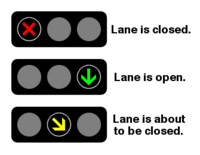
On some high-traffic roads which do not have an even number of total lanes, or on bridges or in tunnels, one or more lanes are designated as counterflow lanes, meaning that the direction of traffic in those lanes can be reversed at any time. Sometimes this is done as a way of managing rush hour traffic (one or more central lanes may flow inbound in the morning and outbound in the evening), in other cases the lanes are only reversed in unsual circumstances (such as a traffic accident or road construction closing one or more of the lanes). Special "lane control signals," placed above the roadway at regular distances, are used for this purpose, with one signal for each lane.
Like regular traffic lights, lane control signals around the world follow their own universal pattern, as specified in the Vienna Convention on Road Signs and Signals. Typical signals include a green downward arrow, used to indicate a lane which is open to traffic facing the signal, a red cross, which indicates a lane is either reserved for opposing traffic or closed to traffic in both directions, and a flashing amber circle, arrow or cross, indicating to traffic facing the signal to immediately clear the lane. (In the Australian state of Victoria, green and yellow are replaced by white, and there may be additional modes such as 'Centre lane turns only' at particular times of the day.)
Unlike regular traffic lights, lane control signals either have one face each to indicate all lane conditions (the so-called "searchlight" configuration), or separate faces for each condition (as illustrated). Lane control signals of the latter type are always placed horizontally. Signals that may indicate other conditions for roads without counterflow lanes also exist, such as those that indicate different speed limits for different lanes.
Traffic lights and the law
In virtually all jurisdictions in which they are used, it is a legal offense for motorists to disregard the instructions of traffic lights (or other traffic control devices). The most common infraction associated with traffic lights is failing to stop for a red light (in some jurisdictions, running a yellow light can also incur a penalty). Enforcement of traffic lights varies from jurisdiction to jurisdiction; some places are extremely strict. Other locales are infamous for traffic lights being routinely ignored by motorists, with no serious attempts by law enforcement to alter the situation.
Jurisdictions differ somewhat on how the deal with "red light running"--attempts by motorists to race to an intersection while facing an yellow light, in an attempt to beat the red. In some locales, as long as the light is yellow when the motorist enters the intersection, no offense has been committed; in others, if the light turns red at any time before the motorist clears the intersection, then an offense occurs. In Oregon and other places, a stricter standard applies--running a yellow light is an offense, unless the motorist is unable to stop safely. This standard has been criticized as ambiguous and difficult to enforce (red light cameras in Oregon are only activated if a motorist enters the intersection on a red).
In some jurisdictions (such as San Francisco), there are ordinances against "gridlocking"--any motorist who enters an intersection (even if on a green light) but does not ensure that he/she can proceed through the intersection, and gets stuck in the middle of the intersection (when traffic ahead fails to proceed), and remains there after the light turns red (thus blocking traffic coming from other directions) may receive a citation.
Enforcement of traffic lights is done in one of several ways:
- By police officers observing traffic through the light, and pulling over and issuing citations to motorists who violate the signal.
- As a result of an accident investigation, if it is determined that one or more motorists ran the red light--even if the incident was not observed by a police officer.
- With red light cameras.
Red light cameras
In some areas, a device usually called a red light camera has come into recent use. A camera is connected to the triggering mechanism for the corresponding traffic light, which is targeted to photograph any vehicle which crosses against the light. The driver or owner (depending on local laws) of a vehicle so photographed can then be fined for violating traffic laws. Such cameras have evoked controversy on a number of fronts: in some jurisdictions, the fine cannot be contested, and is therefore seen by some as a violation of due process. Opposition has also stemmed from the practice of paying commissions to the companies which process the photographs from these cameras, as this is seen as an incentive to falsify images. The presence of a red light camera is sometimes, but not always, indicated by a sign some distance before the intersection.
Traffic lights in other contexts
The symbolism of a traffic light (and the meanings of the three primary colors used in traffic lights) are frequently found in many other contexts.
Use as a rating mechanism or an indication of status
In the UK's British Civil Service and other government offices, traffic lights are used as a coding system for good or bad. For example, for the number of staff one has in relation to the workload, red would mean inadequate, amber would mean reasonable, and green would mean ideal.
In many factories, different stations on the production line(s) are equipped with factory monitoring and control systems; attached to such systems is a "traffic light" status indicator which is generally visible from many places within the factory. Green typically indicates normal levels of production; amber indicates that production has slowed (or attention is otherwise unwarranted); red indicates that production has stopped or the line is down.
In social contexts
In some areas of the US, patrons of various social gatherings use traffic light color coding to indicate availability: red clothing would indicate that the wearer was in a monogamous relationship, amber would indicate a nonmonogamous relationship, and green would indicate that the wearer was single.
Discos
During the mid-to-late 1970s disco craze, discos (especially roller discos), favored a plethora of flashing colored lights. Actual traffic control lights were highly prized, whether stolen or legally purchased retired units. These were generally not controlled in the standard sequence, but driven indirectly from the audio -- flashing with the beat.
Humour
A member of the humourous British website B3ta, known as "Koit", created a series of GIF animations exploring the (often explosive) relationship between the red and green men featured on a UK pedestrian crossing sign. These animations are now featured on their own website, Traffic Light Wars.
